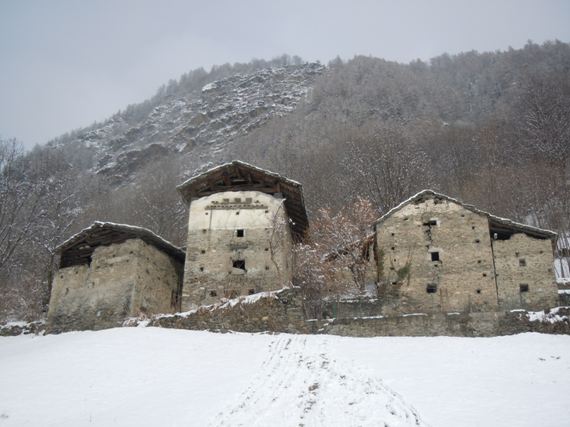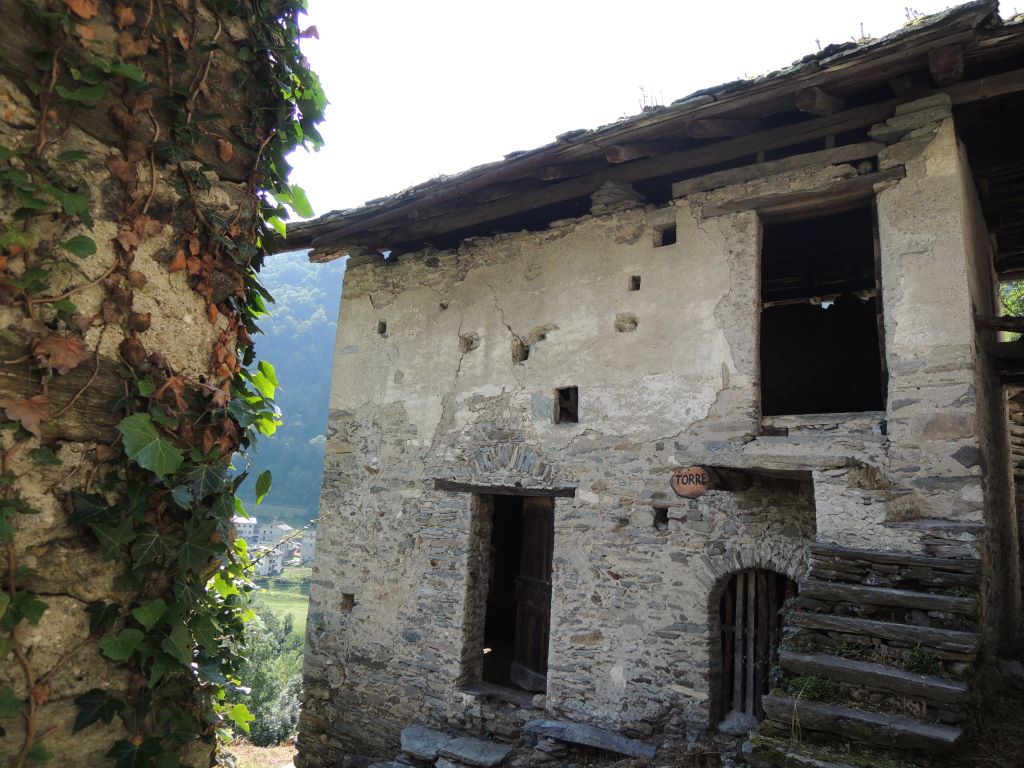by Elvira Ioli
The ancient mediaeval settlement of Melirolo (or Milirolo), 838 m, (IGM map Melirolo, in dialect
Mélirö) is situated towards the north of the municipality of Torre di S. Maria in the hamlet of Cristini.
The beginning of the 12th century saw the first form of association of settlements of the Magnificent Valley of Malenco.
The current municipality of Torre was divided into three ""Quadre":

-
The Quadra of Bondoledo, on the right bank of the River Mallero between the torrents Valdone and Torreggio, included the village centre and the area around the little church of San Giuseppe.
It was buried under a landslide between around 1538 and 1541.
Some of the cattlesheds are still called
“a mundulèe”.
-
The Quadra of Campo, on the right bank of the River Mallero between the torrents Valdone and Giumellini, included the areas next to Sant Anna and Ciappanico.
The origin of the name may have come either from a large piece of cultivated land or from a military base near the church of Sant Anna.
-
The Quadra of Melirolo included all the districts from the Valle del Pettine bordering with Spriana to the mountain of Caspoggio: Romegi, Melirolo, Cristini, Scaja, Dagua, Gianni, Zarri, Marveggia, i.e. the entire left-hand, hydrographic slope of the River Mallero in the municipality of Torre and part of the municipality of Spriana.
Nowadays, Melirolo is deserted and a nucleus of ten/twelve cattlesheds, hay barns, wood stores and abandoned buildings remains.
An old packhorse road passes through and continues as far as the mountain of Caspoggio.
The buildings were made of local wood and stone, partly plastered with lime.
They all have small, narrow entrances, suitable for both summer and winter climates: they could easily be closed with salvaged material (hay, foliage) to keep in the heat in winter and keep it cool in the summer.

Particularly evident amongst these buildings is the
guard and control tower, built on the remains of a square Roman tower.
It is a white, plastered building with numerous small, square, aligned openings and at the top are three crenels giving a wide view over the valley.
Access was via a ladder, which they put out or withdrew depending on whether the situation was peaceful or dangerous.
It was used as a dovecote or pigeon house and the interior walls have numerous carved niches, which housed the birds in calmer times.
Homing pigeons or light signals were used to communicate with other towers located alternately on the left or right bank of the Mallero: the tower of
Cà de risc, the castle on the hill towards Caspoggio, the old district of Torre, the castles of Volardi, Spriana, Cagnoletti, etc.
From the three crenels they were able to control the movements of traders and soldiers in the event of an attack.
The tower was part of the
sighting system for the Magnificent Valley of Malenco during periods of conflict or intense commercial trade between the Valtellina and nearby Switzerland across the Muretto pass.
Lower down is the
bishops' room,
where the heads of the family of the Quadra of Melirolo used to meet to discuss and take decisions for the community.
These sometimes included the heads of the Zarri, Scaia, Dagua and Gianni families.
At other times, there were the representatives of the various "quadre" of the Valmalenco (Bondoledo, Campo, Melirolo, San Giacomo, Caspoggio, Lanzada) with the oldest man chairing the assembly.
The plague in Melirolo
In the first half of 1600 (1630), the district of Melirolo was also hit by the
plague.
Historians tell how the infection, which spread throughout the Magnificent Valley of Malenco, was one of the worst.
The population of the Valtellina dropped from about 150 thousand inhabitants to 40 thousand and the population of the Valmalenco was reduced to just over 800 people.
Over one thousand people died in this epidemic.
The inhabitants of Melirolo, in particular, suffered tragically: they all died!
For fear of contagion or through lack of people able to do it, the dead were not even buried in the cemetery: they remained abandoned in their homes or outside.
No-one went to the district any more and as time passed people began to speak of strange visions of furtive shadows, which went around at night.
The dead became restless ghosts.
Here is the
legend of the ghosts, which has been passed down from one generation to another.
Oh passer-by, as you walk in the grassy alleys between these cowsheds, towers and mills, remember that, once upon a time, we young men of Melirolo were not given a decent burial.
Now, in order not to allow you all to forget the fatal moment of our death caused by the plague, we walk around day and night amidst this silence and abandonment, because we can have no peace.
You feel a breath of wind, a light rustling of leaves, a whistle through the walls and we are here, and we will never leave this desolate land, which has now become sacred.
Once the fear of this serious epidemic had passed, the hunt began for the person to blame for the spread of the plague.
Four young girls were held responsible and called
witches.
They were tried, tortured and killed.
There was also a girl-witch from Torre,
Domenica Volarda, who lived in the district of Volardi, who died on 8 October 1634 as a result of the torture she had suffered.
Later, in 1672, another epidemic of the plague returned to hit the entire Valmalenco.
Once again, they tried to blame the so-called witches and so a certain
Maria Dell’Avo from Melirolo was burnt alive in Sondrio.
Melirolo and its mills
The water of the torrent Torno, which flows north of Melirolo, was used to work many mills.
The el mulìn di mulinèe, where mulinèe means miller, is still in fairly good condition.
The ancestors of the Cristini family were millers for many years.
Here they milled
rye, maize and barley, which were the cereals grown on the
terracings , which were once very fertile and profitable and which now lie complete;y abandoned.
Our grandparents' stories tell us that there were three of four mills in this area.
However, there were certainly others further up the mountainside for the people of the hamlets overlooking the valley.
They were run using the water from the torrent Torno, which begins below the district of Gianni.
Over the years, this torrent has flooded several times and caused destructive land and mudslides.
Some excavations in the area found domestic utensils and objects of daily life.
Our grandparents also tell the story of how the Torno comes from an infiltration of water from Lake Poschiavo in the valley of the same name in Switzerland.
The story has been passed down that a lorry full of straw brooms tipped over into the Swiss lake and for a long time the water of the Torno carried remains of broom corn.
Is it true? People have asked if the story has been verified but no-one has been able to answer that!
Bibliography
-
Luigi De Bernardi,
Valmalenco: una lunga storia,
Sondrio 1986
-
Ezio Pavesi,
Val Malenco,
Sondrio 1969